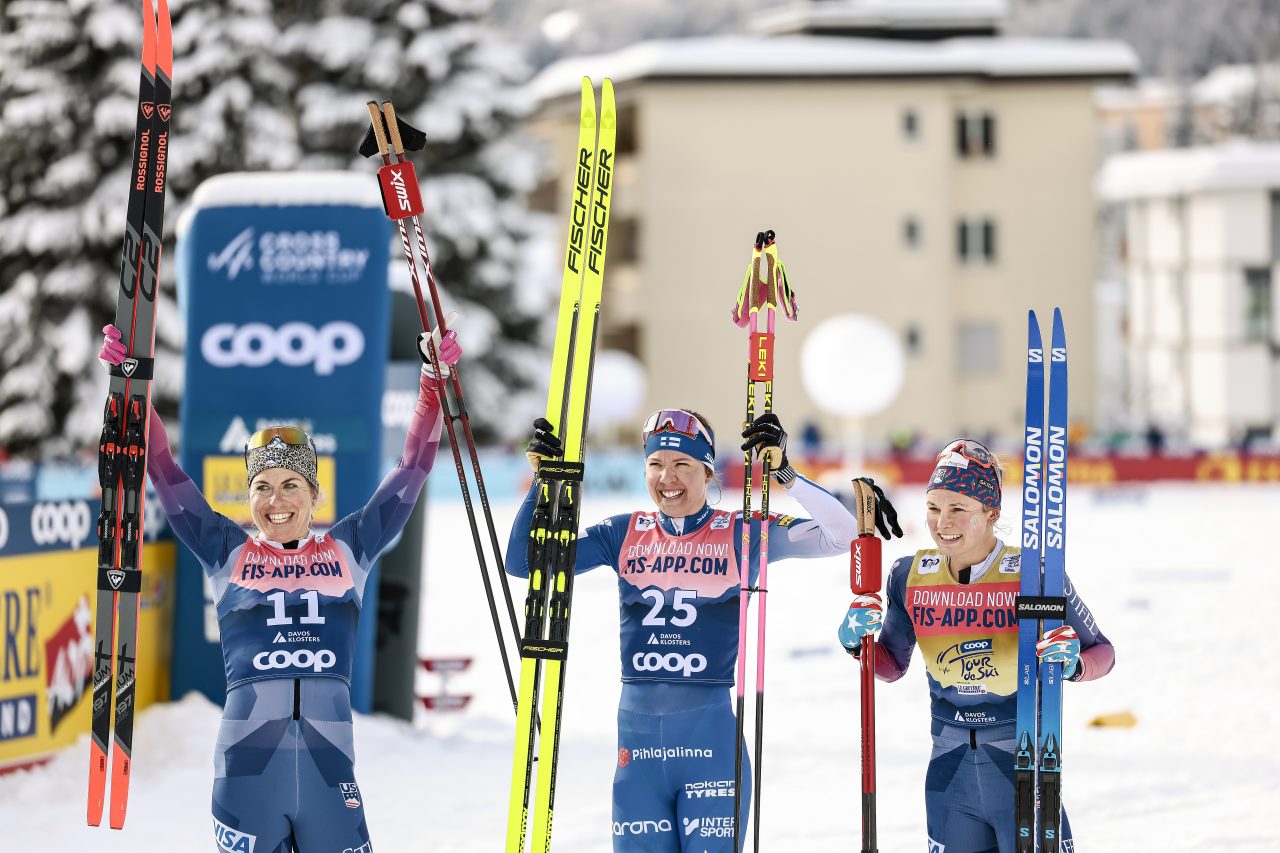 This coverage is made possible through the generous support of Marty and Kathy Hall and A Hall Mark of Excellence Award. To learn more about A Hall Mark of Excellence Award, or to learn how you can support FasterSkier’s coverage, please contact info@fasterskier.com.
This coverage is made possible through the generous support of Marty and Kathy Hall and A Hall Mark of Excellence Award. To learn more about A Hall Mark of Excellence Award, or to learn how you can support FasterSkier’s coverage, please contact info@fasterskier.com.
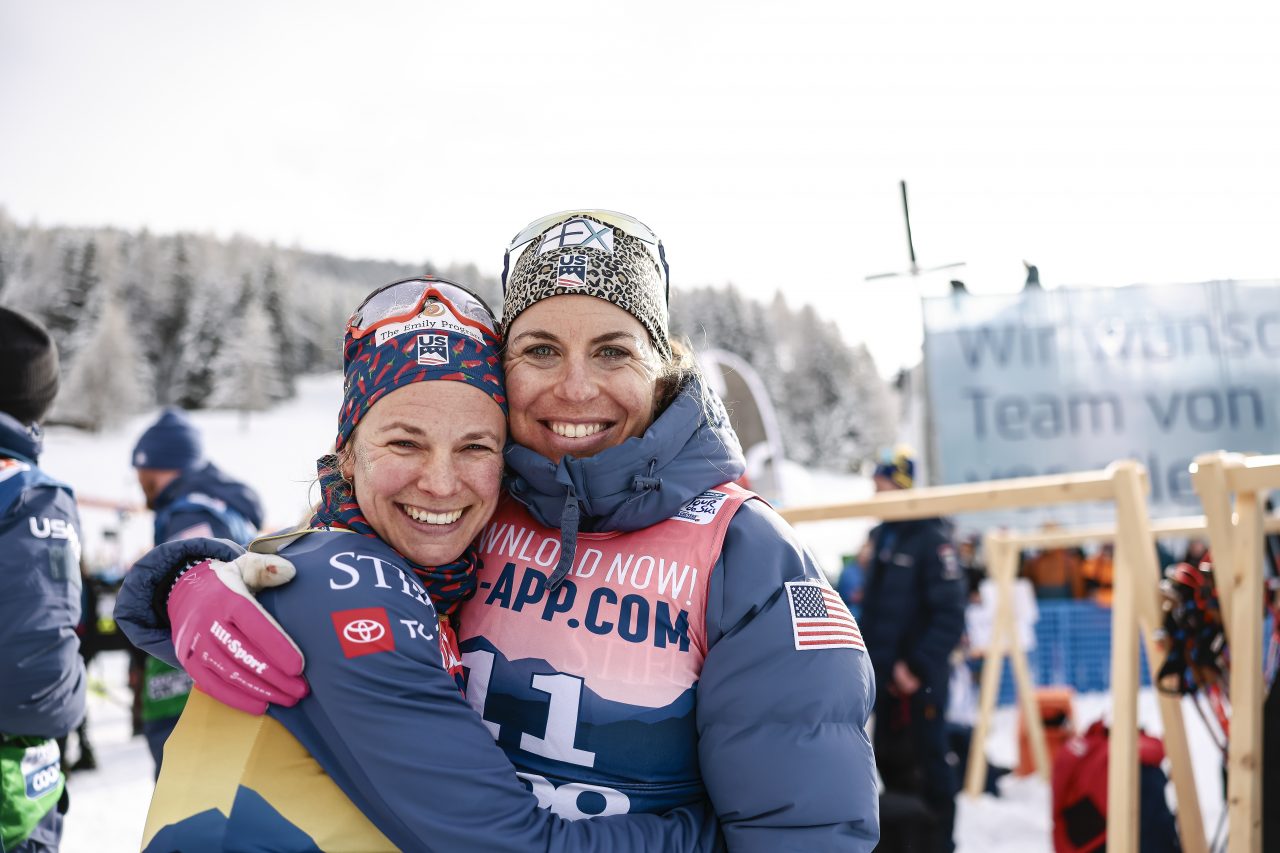
The Tour de Ski (TDS) continued in Davos, Switzerland, with the 20 kilometer Classic Pursuit. Jessie Diggins (USA) entered the women’s race with a 33 second lead in the overall standings over yesterday’s Sprint winner Linn Svahn (SWE), and a 1:22 lead over Jonna Sundling (SWE).
A 20 kilometer Classic race is a long way; a lot can happen. Just a little too much kick wax, and 33 seconds can vanish in a flash. Svahn has a lengthy resume of top ten distance Classic race finishes, so putting over 30 seconds into Diggins was definitely a possibility. With another Classic race coming on Saturday, Diggins didn’t have much of a margin to work with and would need every bit of the starting cushion she had. A potential wildcard was that Svahn carried a yellow card for a technique violation with her into the race. If she received another violation, her day—and her Tour—could be done.
Entering the race, Rosie Brennan (USA) was in 12th in overall standings, 2:44 behind Diggins. Sophia Laukli was in 20th, and now that she has survived the Sprints, the long distance specialist would have a chance to move up the standings.
The 20 k Classic Pursuit format featured a little different setup: according to TDS rules, the start order was assigned according to the prior stage’s Sprint results instead of the traditional method of using the overall standings. This meant Linn Svahn (SWE) would be the first racer to start. She would be followed by Diggins even though Diggins finished third yesterday. Diggins went second because yesterday’s second place finisher Kristine Stavaas Skistad (NOR)—a sprint specialist—opted to withdraw from the TDS.
To make formatting matters even more confusing, the International Ski Federation (FIS) initially published a start list that included wave starts for the pursuit, something allowed for in TDS rules. But, shortly after issuing the start list, they rescinded it after they realized that it would be a nightmare for television viewers trying to follow along at home.
Another point of confusion was the race length. The race was billed as 20 kilometers and in fact was 22 k.
After officials decided how the race would start, it was left to the skiers on the course to decide their fates in the TDS. It turned out to be a wild day full of ups and downs for everyone. After all of the excitement, it was Kerttu Niskanen (FIN) who edged out Rosie Brennan (USA) for first place in a thrilling finish. Jessie Diggins (USA) overcame an early fall and took third place.
Other Americans also had excellent performances today. Novie McCabe finished 19th, only 27 seconds off the lead (and beating Tour contender, Svahn). Sophia Laukli finished 25th, 41 seconds back. Sammy Smith had another good day finishing 28th. Julia Kern did not start today as she is continuing to recover from health issues and wanted to focus on being rested for the remainder of the World Cup season.
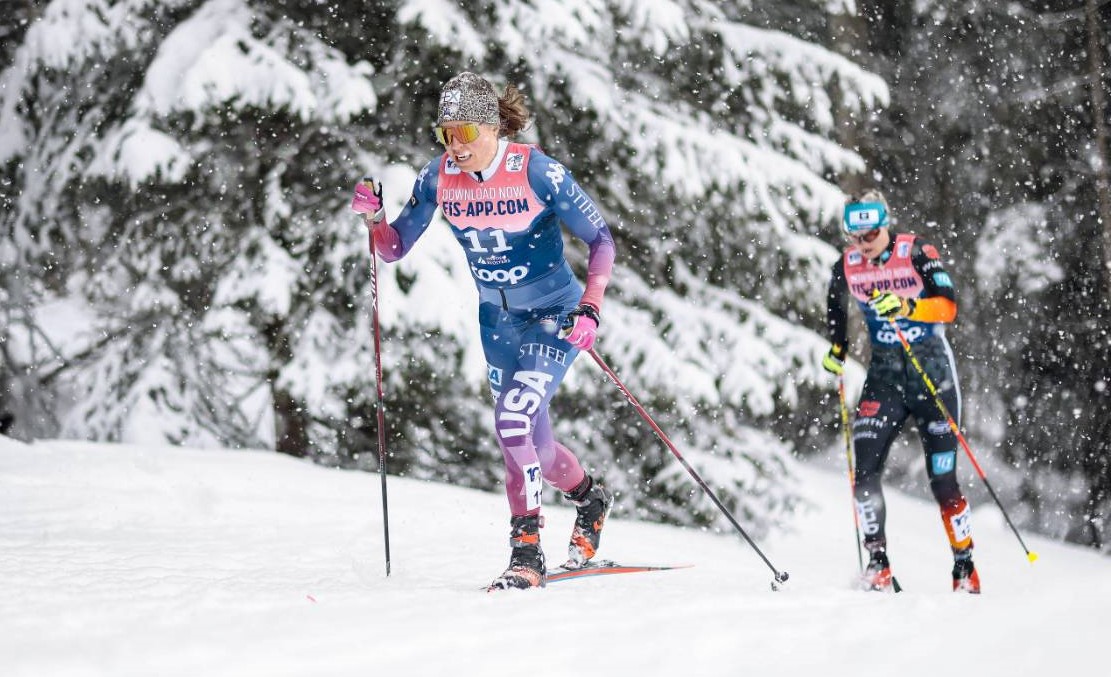
Rosie Brennan (USA) chose the right tactic by going with kick and glide instead of double poling. (Photo: NordicFocus)
20 Kilometer Classic Pursuit
The Davos Pursuit course race consisted of two ten kilometer laps; another unusual format for World Cup racing. But the biggest factor was that it was snowing heavily, with temperatures close to freezing; always a Classic waxing nightmare. Bad decisions—or bad luck—in the waxing process could ruin a racer’s day. Because of this, several of the Swedish women decided to double pole the course and herringbone up the hills through the restricted technique zones. It was a choice Brennan eschewed, “I honestly didn’t consider double poling,” said Brennan. “[I didn’t] consider using anything other than the skis that my tech put in front of me today. I was just focused on making those skis the best skis that I could.”
The unusual starting pursuit format turned out to work to Diggins advantage since at least one skier ahead of her would be breaking the track.
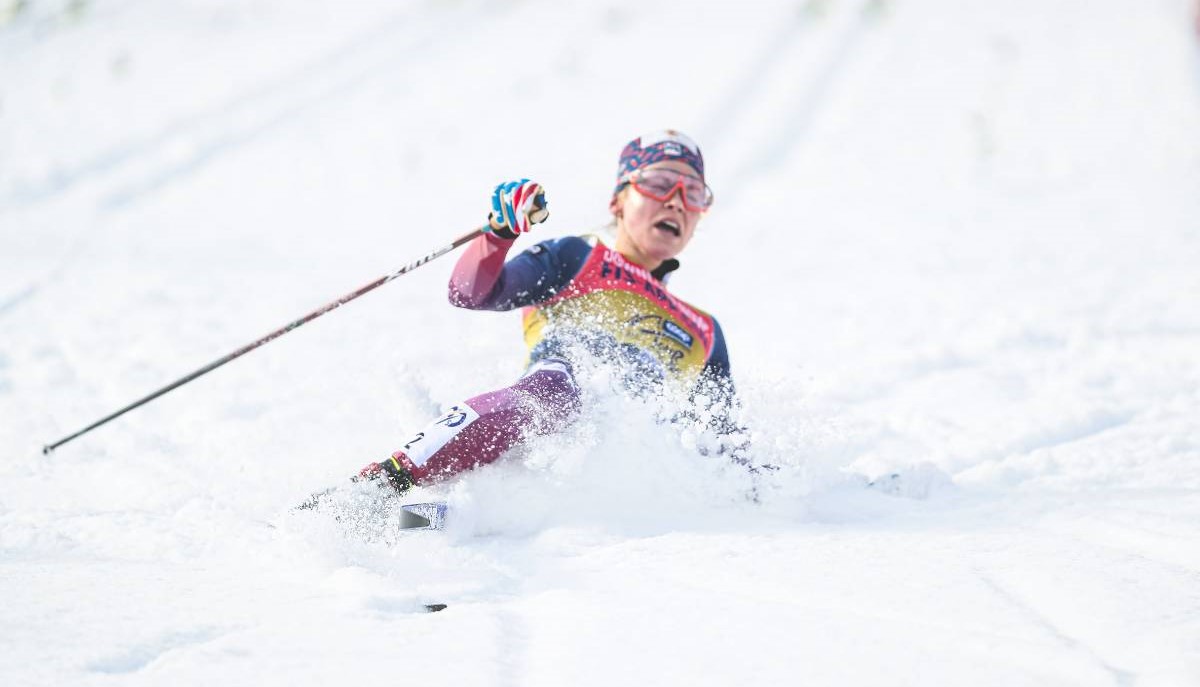
Early on, Diggins was passed by Maja Dahlqvist (SWE) and Johanna Hagstroem (SWE). Then, only 6:30 into the race, Diggins tripped and fell hard on a flat section of the course. She was only down for a second, but the damage was done. She immediately was separated from the leaders, dropping eight seconds behind them, now working on her own and trying to gather herself after a hard dramatic fall. It was definitely not the start to the day that Diggins wanted. After the race, Diggins acknowledged it was a hard fall. “It hurts, a lot actually”, said Diggins. “I’m glad I have a day to rest, but it will be ok.” When asked about the mechanics of the fall, “I caught my kick wax on the freshly shoveled snow on the first road crossing, which is why I fell,” Diggins observed. ” I was careful to stagger my skis on the crossings after that!”
After the fall, a group of chasers caught Diggins; at least she was no longer skiing alone. This was a huge, fortuitous, piece of good luck for Diggins since the group was closing in quickly on the leaders. The group helped Diggins regain contact with the front of the race without having to expend as much energy as she would have on her own. An additional piece of help came when after the gap was closed, the pace slowed considerably, and pack racing tactics took over for a while.
The race continued to slow into one giant pack. But then Rosie Brennan (USA) shot to the front to push the pace along with Tour contender Victoria Carl (GER). Diggins had been swallowed up by the group and dropped all the way to 17th; ominous signs for the Tour-leading American.
At 5.7 kilometers, long distance expert Astrid Oeyre Slind (NOR) made her presence felt when she went to the front with Linn Svahn. Svahn would repeatedly test the pace knowing that today was her chance to gain time on Diggins. It was clear that Svahn had made a choice to go with little or no kick wax as she was double poling the entire time. At this point, Brennan had dropped back significantly, to 16th, and Diggins was 22nd, The placings sounded bad, but the time gap wasn’t terrible. Diggins was only 11 seconds off the lead.
Meanwhile, Sophia Laukli (USA) was making a big charge. She started 44th, and had now pushed herself up to 20th; at that point, ahead of Diggins.
At 8.6 kilometer Svahn made it back to the lead and was alternating pulling at the front with her teammates. The race had turned into a contest between those double poling and racers who were striding. Skiers lacking kick wax gained an advantage on every downhill, but those racers paid a high price when the groups hit big climbs. As the competitors neared the stadium, those without kick wax had to herringbone up the entire length of big hills, losing large chunks of time.
As the skiers continued on a long climb at 9.5 kilometers, most of the pack severely bogged down as many of the leaders were forced to herringbone. It clogged up the race and closed the pack considerably.
Whenever a Classic race is contested, Niskanen’s name comes up. Not surprisingly, at this point Niskanen joined the leaders. Brennan was out front again and Diggins had tenaciously clawed her way back up to ninth, only 18 seconds off the lead. More importantly, Svahn had fallen back and was now trailing Diggins. It was a dramatic change of events in a short amount of time, and was beginning to show a flaw in the Swede’s plan of not relying on kick wax. When asked about her own waxing situation, “my kick came and went during the race,” Diggins said. “But luckily I had just enough when I needed it to be able to make my way up that big last climb. Hats off to our amazing tech team for giving us such amazing skis in a crazy snowstorm!”
Simultaneously, Brennan made another bid for the lead and went to the front with Niskanen right behind her. Just past the halfway mark, there was one more significant downhill; again, those with better glide went to the front. Diggins continued to gain on the race leaders, and she was only 5.6 seconds off the lead with Svahn right with her. But the most significant thing was that Diggins had seemed to regain her momentum and was no longer in emergency mode. She had remarkably found her rhythm again and looked strong.
At this point Svahn received a verbal warning for a technique violation. It was not a yellow card which would have disqualified her. It was an interesting decision to issue the warning instead of a yellow card. But for this generous officiating decision, Svahn’s day could have ended.
With only 4.3 kilometers to go, Svahn was at the front again. Racers still had one more big climb ahead of them before they would have the finish in sight. At this point Slind went back to the front taking Svahn with her. But, as had happened in prior climbs, the skiers lacking kick struggled. Diggins took the opportunity, striking like lightning and passing Svahn. It was shocking to see Diggins who had encountered so many struggles throughout the day fighting to overtake Svahn who had seemed determined to stay at the front.
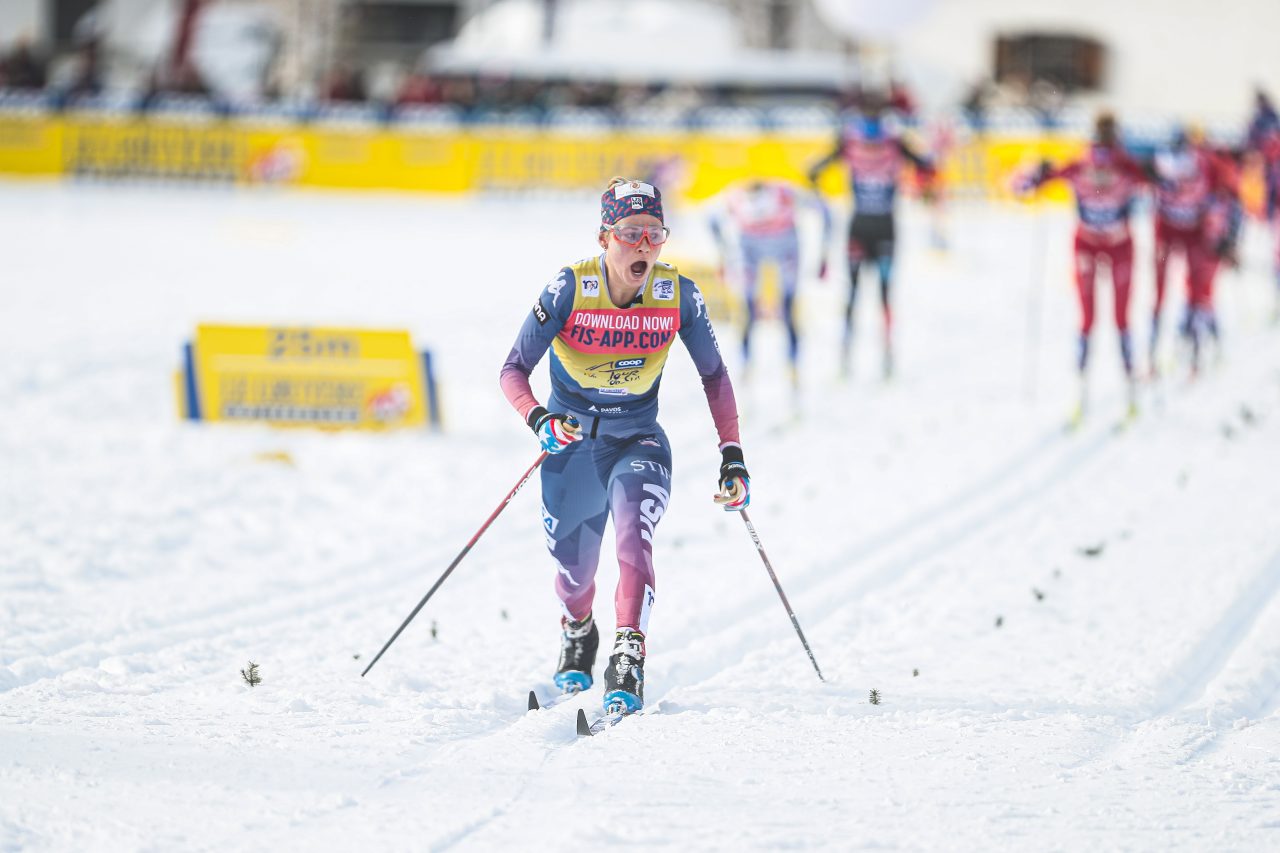
As the climb continued Brennan took advantage and went to the front. The hill continued to take its toll, and skiers who had gone without kick wax paid a huge penalty as they struggled to double pole or herringbone up the hill. It was a scenario Brennan had anticipated, “that climb at the end, that’s my strength.” she said. “I felt I could use that to my advantage if I had kick wax on, that was my goal, I just wanted to push the climbs and make the double poling skiers hurt and sit in on the downhills and flats, and try to save for the climbs. That last climb is really big so having kick wax really helps there.” It was a cagey smart veteran move which helped to put her onto the podium.
Brennan was now being chased by Niskanen. Remarkably, Diggins was up to fifth. She too, was herringboning up the final steepest section of the last hill, but she was able to make additional gains and moved to fourth. Brennan and Niskanen battled at the front, establishing a little bit of a gap on the field. With two kilometers, left they had a ten second gap on the field when Niskanen went to the front to try and separate herself from Brennan. At the same time Diggins was locked in a battle with Margrethe Bergane (NOR) for the final podium spot. It was hard to believe that not long ago, Diggins was lying flat on the ground, seemingly out of the race and maybe out of the Tour lead.
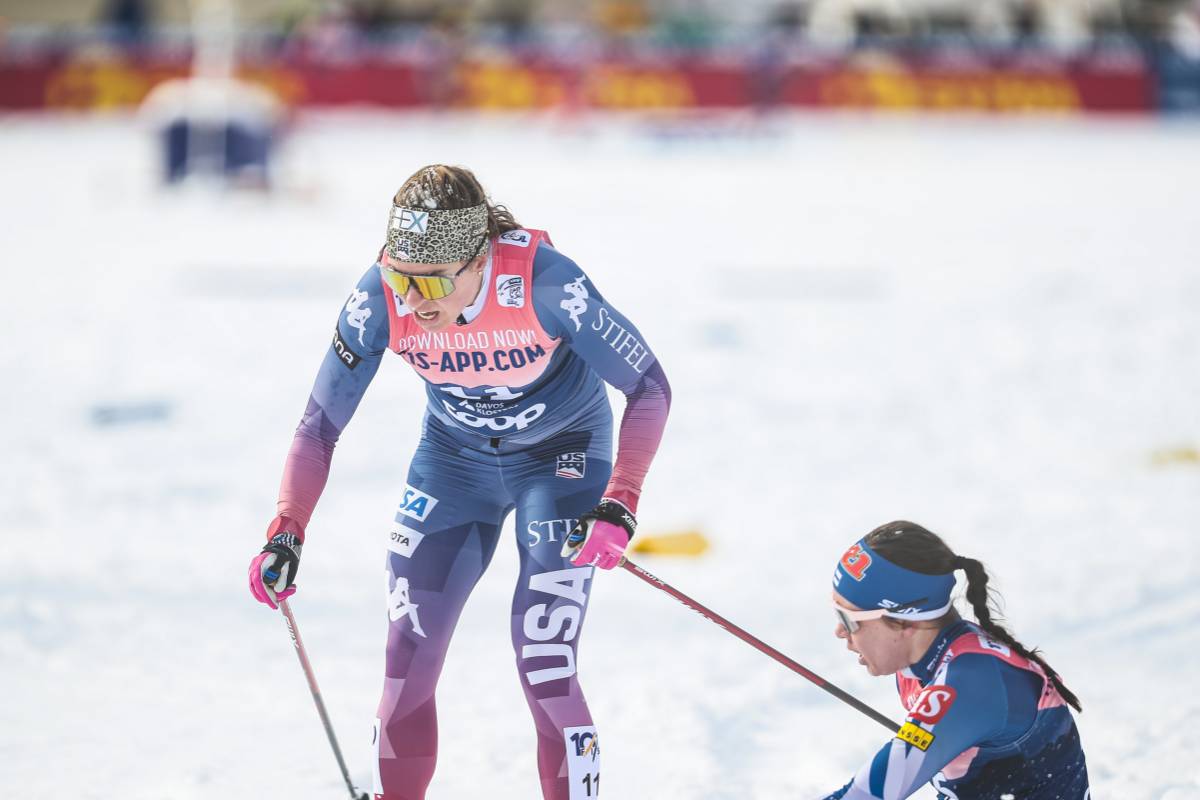
Niskanen and Brennan entered the stadium entrance together where additional tracks were now available. Brennan stepped onto her own track and briefly passed Niskanen as the two jockeyed for position. Niskanen passed Brennan back as Brennan desperately clung to the Finn’s ski tails. But as they entered the final straightaway Niskanen pulled away slightly. Brennan’s fate was sealed; she didn’t have enough time to close on Niskanen, and finished second. Right behind her, amazingly, was Jessie Diggins. It was a remarkable finish for both Americans.
It was a great day for Brennan, and a redeeming podium finish in what has been a challenging Tour. For Diggins … she had just given a master’s class in race management and Tour strategy.
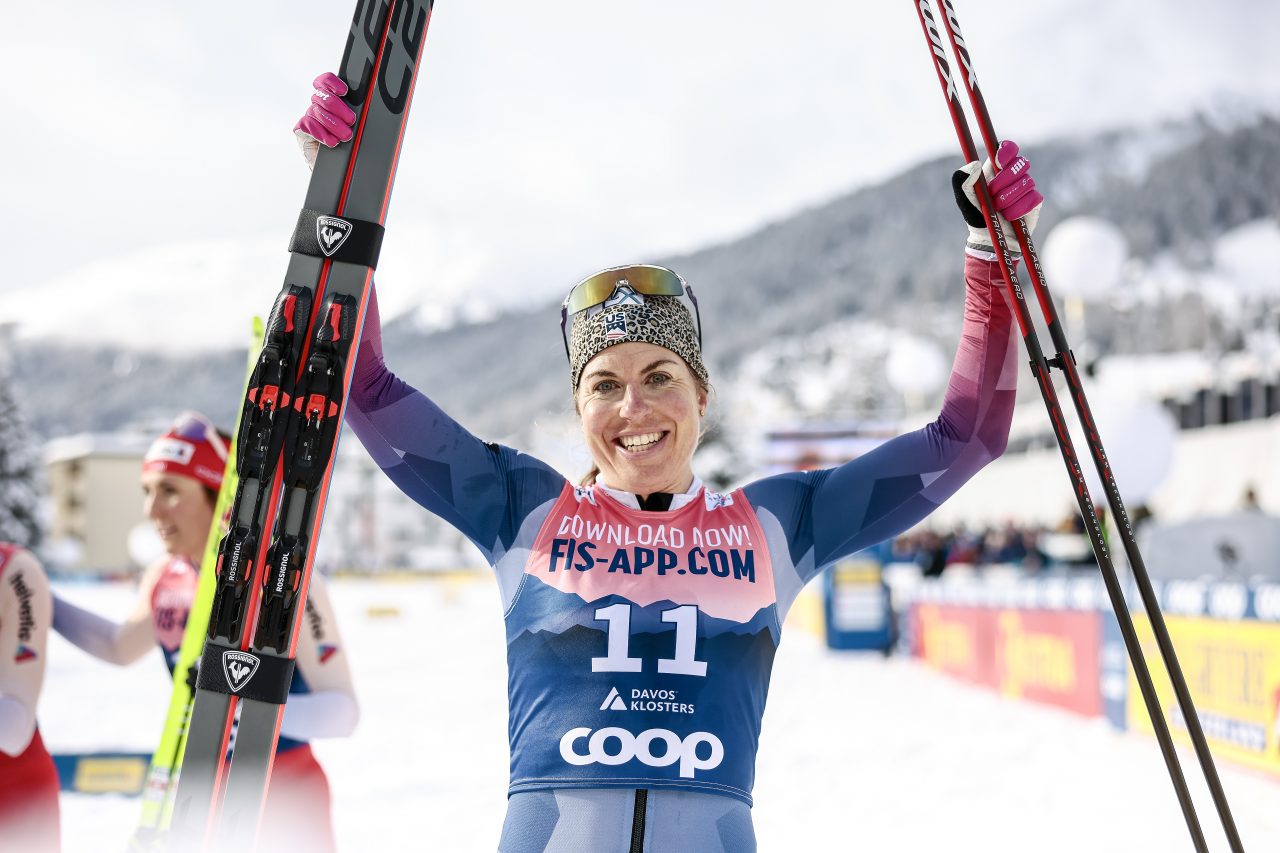
Tour de Ski Standings
It was all a bit surreal for Diggins. Early on, her lead in the Tour was evaporating, and it looked like she could lose her first place position. But somehow, she found another level to keep her Tour lead. Diggins had fought back. Svahn—who put in an all or nothing strategy—dropped to seventh place, over a minute behind Diggins. Niskanen took over second place , 44 seconds behind Diggins. Jonna Sundling (SWE) was in third place, 52 seconds back. Victoria Carl, dropped all the way to eighth, 1:39 off the lead, and it looked like her podium chances were gone.
Rosie Brennan helped her cause significantly, moving into tenth place 1:56 behind Diggins, but only 1:04 off a podium spot. With two stages left, Diggins is in control of her own destiny. Next, the Tour de Ski moves to Val Di Fiemme, Italy, for a 15 kilometer Classic mass start, followed by the lung-busting climb up Alpe Cermis.
